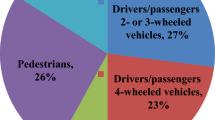Abstract
Background
“Road rage” has increasingly generated public concern, however, the prevalence of this behaviour has not been available. We examine the prevalence and demographic correlates of road rage victimization and perpetration based on a population survey of adults in Ontario.
Methods
Data are based on the CAMH Monitor, a repeated cross-sectional telephone survey of Ontario adults (n=1,395). The contribution of demographic factors to road rage was examined with logistic regression analysis.
Results
About half of respondents (46.6%) were shouted at, cursed at or had rude gestures directed at them in the past year, and 7.2% were threatened with damage to their vehicle or personal injury. Nearly a third of respondents (31.7%) admitted to shouting, cursing, etc. at someone, and 2.1% threatened to hurt someone or damage their vehicle. Being a Toronto resident, being younger, and earning a higher income were associated with greater likelihood of being a victim of shouting, cursing and rude gestures; however, income was not associated with being threatened with vehicle damage or injury. The likelihood of admitting to shouting, etc. at someone was greater for males, younger respondents, Toronto residents, higher income earners, and never married respondents; however, threatening someone was associated with younger age and lower education level.
Conclusion
These results provide a first indication of the prevalence of road rage in Ontario. Road rage, in its milder forms, appears to be common, involving between a third and a half of respondents as either a victim or a perpetrator. Nearly 1 in 10 Ontario residents were threatened with damage or personal injury.
Résumé
Contexte
La « rage au volant » préoccupe de plus en plus le public. On manque toutefois de chiffres sur la prévalence de ce comportement. Nous examinons ici la prévalence de la victimisation due à la rage au volant et ses corrélats démographiques en nous basant sur un sondage auprès d’adultes ontariens.
Méthode
Les données sont fondées sur l’Indicateur du CTSM, une enquête transversale annuelle effectuée auprès d’adultes ontariens (n=1 395). Le rôle des facteurs démographiques dans le phénomène de la rage au volant a été examiné à l’aide d’une analyse de régression logistique.
Résultats
Environ la moitié des répondants (46,6 %) ont été la cible de cris, d’insultes ou de gestes obscènes au cours de l’année écoulée, et 7,2 % des répondants ont été menacés de dommages à leur véhicule ou de blessures. Presque le tiers des répondants (31,7%) ont avoué, entre autres, avoir insulté une autre personne ou avoir crié contre elle, et 2,1 % des répondants ont menacé un autre conducteur de blessures ou de dommages à son véhicule. Le fait de résider à Toronto, d’être relativement jeune ou d’avoir un revenu relativement élevé étaient tous des facteurs associés à une plus grande tendance à être l’objet d’insultes, de cris ou de gestes obscènes. Toutefois, le revenu n’était pas associé au fait d’être menacé de dommages à son véhicule ou de blessures. Les hommes, les répondants relativement jeunes, les résidants de Toronto, les personnes ayant un revenu relativement élevé et les personnes n’ayant jamais été mariées étaient plus susceptibles d’avouer, entre autres, avoir crié contre quelqu’un. Cependant, le fait de proférer des menaces était associé à un plus jeune âge et à un moindre niveau d’instruction.
Conclusion
Ces résultats donnent une idée de la prévalence de la rage au volant en Ontario, phénomène qui, dans ses formes plus bénignes, semble être répandu et touche entre le tiers et la moitié des répondants, à titre de victimes ou d’agresseurs. Près d’un résidant de l’Ontario sur dix s’est fait menacer de dommages à son véhicule ou de blessures.
Similar content being viewed by others
References
Smart RG, Mann RE. Deaths and injuries from road rage: Cases in Canadian newspapers. CMAJ 2002;167(7):761–62.
Stein J. Fact sheet: Major causes of death in Canada, 1993–1995. Chron Dis Can 1997;18:91–92.
Statistics Canada. Causes of Death. Ottawa: Ministry of Supply and Services, 1994.
Moore R, Mao Y, Zhang J, Clarke K. Economic burden of illness in Canada, 1993. Chron Dis Can 1997;18:95–96.
Fong G, Frost D, Stansfeld S. Road rage: A psychiatric phenomenon? Soc Psychiatr Epidemiol 2002;36:277–86.
Parker D, Lajunen T, Summala H. Anger and aggression among drivers in three European countries. Accid Anal Prev 2002;34:229–35.
Adlaf EM, Ialomiteanu A. CAMH Monitor 2001: Technical Guide. Toronto: Centre for Addiction and Mental Health, 2002 [Available in PDF format].
Hosmer DW, Lemeshow S. Applied Logistic Regression. New York: John Wiley & Sons, Inc., 1989.
Wells S, Graham K, West P. Alcohol-related aggression in the general population. J Stud Alcohol 2001;61:626–32.
Ontario Ministry of Transportation. Ontario Road Safety Annual Report. Toronto: Ontario Ministry of Transportation, 1997.
Phebo L, Dellinger AM. Young driver involvement in fatal motor vehicle crashes and trends in risk behaviors, United States, 1988–95. Inj Prev 1998;4:284–87.
Author information
Authors and Affiliations
Corresponding author
Rights and permissions
About this article
Cite this article
Smart, R.G., Mann, R.E. & Stoduto, G. The Prevalence of Road Rage. Can J Public Health 94, 247–250 (2003). https://doi.org/10.1007/BF03403543
Received:
Accepted:
Published:
Issue Date:
DOI: https://doi.org/10.1007/BF03403543




